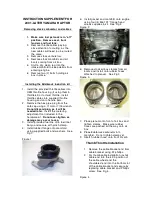
Renew the components in the slightest doubt in serviceability.
Flexible hoses, irrespective their condition, should be
renewed after 100000 km or after 5 years of vehicle operation to
prevent sudden breaks due to aging.
After five years of operation it is recommended to renew the
brake liquid.
Servo unit -serviceability check
Press the brake pedal 5-6 times with the engine not working
to create in cavities A and B (fig. 6-2) identical pressure close to
atmospheric. Simultaneously, by effort applied to the pedal,
define, whether the valve housing 21 is jammed.
Stop the brake pedal in the middle of its travel and start the
engine. If the servo unit is OK, the brake pedal after engine start
should "go forward".
If the pedal does not "go forward", check the fastening of the
hose end piece, condition and fastening of the end piece flange
in the booster, hose-to-end piece fastening and connection to the
engine inlet pipe, because loose fastening or damage will signifi-
cantly reduce the underpressure in cavity A and performance effi-
ciency of the unit.
In case of vehicle spontaneous braking, check the servo unit
for leak-proofness with the engine running , first with a released,
and then depressed motionless brake pedal. "Sticking" of the pro-
tective cap 13 to the valve housing tail and hissing of inleaking air
will indicate insufficient tightness of the servo unit. In these cases
the unit should be renewed.
Brake drive adjustment
The free travel of the brake pedal with engine not working
should be 3-5 mm. This size is received by adjusting the position
of the stoplight switch 7 (fig. 6-3).
If the stoplight switch is too close to the pedal, it does not
come back to the initial position, valve 18 (see fig. 6-2), being
pressed to housing 21, separates cavities A and B, and it results
in incomplete release of wheels when the pedal is let off.
To adjust the stop-light switch position slacken nut 8 and by
rotating nut 9 (see fig. 6-3) position the switch so that its buffer
will slightly touch the pedal rest, thus the pedal free travel should
make 3-5 mm. After adjustment tighten nut 8.
ATTENTION. The brake pedal free travel adjustment is
made with the engine not working.
If the adjustment of the stoplight switch fails to remedy the
brake mechanism, disconnect the master cylinder from the servo
unit and check the protrusion of the adjusting bolt 4 (see fig. 6-2)
in relation to the fastening plane of the master cylinder flange
(size 1.25
-0.2
). This size can be established by holding with a spe-
cial key the end of rod 3, and with the other key screwing in or
undoing bolt 28.
Handbrake adjustment
Note.
In the end of year 1995, the design of the handbrake
lever quadrant was changed - the first tooth of the sector became
double and thus the order of adjustment, marked below in the text
with a "*" sign, has changed.
If the handbrake does not hold the vehicle on a slope up to
25 % when moving the lever by 4-7 (2-8) * teeth of the quadrant,
adjust the handbrake in following order:
- shift the handbrake lever to the lowest position and then lift
by 1-2 teeth of quadrant (this operation is carried out only for the
gear sector of the "old" design);
- slacken locknut 5 (fig. 6-4) and by turning the adjusting nut
6 take up cable 1;
- check the full travel of the handbrake lever, which should be
4-5 (2-4)* teeth on the quadrant, then tighten locknut 5.
Apply the brake pedal several times to ensure that the lever
travel does not change and wheels rotate without jamming at fully
lowered lever.
Note.
If the cables were renewed, depress the brake pedal
two or three times applying force on the lever of approx. 392 N
(40 kgf). Thus the cables will be stretched.
Pressure regulator serviceability check
Position the vehicle on a lift or over an inspection pit, clean
the pressure regulator and protective cover from dirt.
Carefully remove the protective cover from the pressure reg-
ulator, remove the remains of greasing and clean the "torsion-to-
piston" connection.
123
Fig. 6-3. Brake pedal:
1 - master cylinder; 2 - servo unit; 3 - bracket; 4 - sealant cup; 5 - clutch/brake
pedal mounting bracket; 6 - brake pedal return spring; 7 - stop light switch; 8, 9
- nuts; 10 - stoplight buffer; 11 - brake pedal; 12 - push rod
Содержание Niva 4x4
Страница 80: ...135 ...
Страница 81: ...136 ...














































